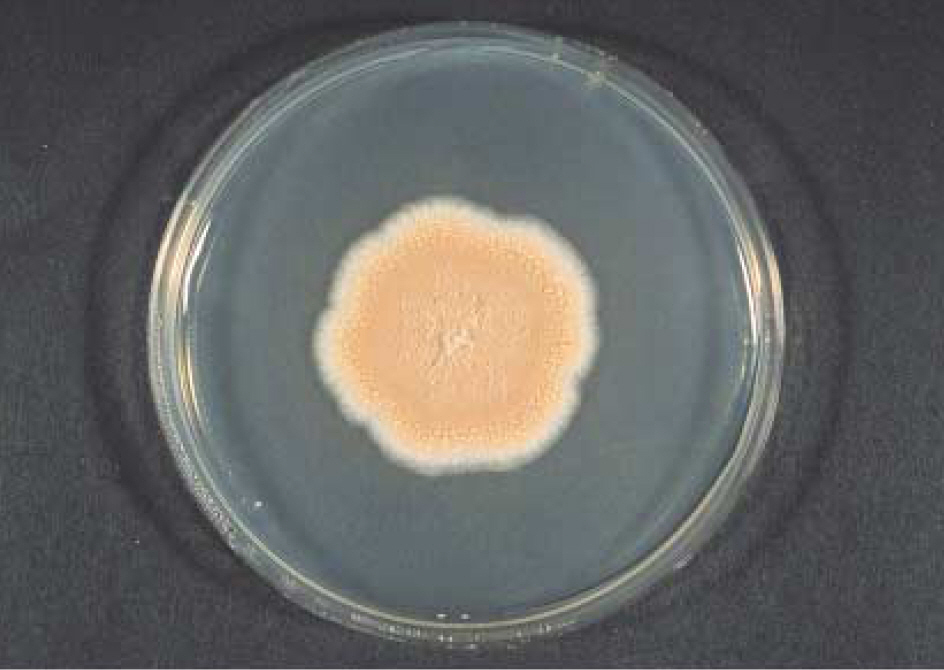Korean J Lab Med.
2006 Feb;26(1):32-35. 10.3343/kjlm.2006.26.1.32.
Infection with Scopulariopsis brevicaulis after Cosmetic Surgery of the Face
- Affiliations
-
- 1Department of Laboratory Medicine, Chonnam National University Medical School, Gwangju, Korea. shinjh@chonnam.ac.kr
- KMID: 2143194
- DOI: http://doi.org/10.3343/kjlm.2006.26.1.32
Abstract
- Scopulariopsis brevicaulis is a ubiquitous soil saprophyte that commonly causes onychomycosis, accounting for 1-10% of such infections. Rarely, it may be responsible for cutaneous lesions or more severe infections, especially after traumatic or surgical injuries. We report of a 54-year-old female patient who developed facial cellulitis caused by S. brevicaulis, which occurred one year after the patient underwent cosmetic surgery of the face. The patient suffered from febrile sense, pain and a growing mass lesion on her left cheek, which were diagnosed as facial cellulitis associated with foreign material that had been implanted at the time of cosmetic surgery. Three pus cultures from the mass lesion which performed at a week interval yielded the same S. brevicaulis. Surgical removal and drainage by using liposuction procedure resulted in a favorable outcome. To our knowledge this is the first report of S. brevicaulis infection associated with cosmetic surgery in Korea.
MeSH Terms
Figure
Cited by 1 articles
-
Onychomycosis Caused by Scopulariopsis brevicaulis: Report of Two Cases
Myung Hoon Lee, Sung Min Hwang, Moo Kyu Suh, Gyoung Yim Ha, Heesoo Kim, Jeong Young Park
Ann Dermatol. 2012;24(2):209-213. doi: 10.5021/ad.2012.24.2.209.
Reference
-
References
1. Kwon-Chung KJ, Bennett JE. Infections due to miscellaneous molds. Kwon-Chung KJ, Bennett JE, editors. Medical mycology. Malvern: Lea&Febiger;1992. p. 733–67.2. Sigler L, Verweij PE. Aspergillus, Fusarium, and other opportunistic moniliaceous fungi. Murray PR, Baron EJ, Jorgensen JH, Pfaller MA, Yolken RH, editors. Manual of Clinical Microbiology. 8th ed.Washington, D.C.: American Society for Microbiology;2003. p. 1726–60.3. Aguilar C, Pujol I, Guarro J. In vitro antifungal susceptibilities of Scopulariopsis isolates. Antimicrob Agents Chemother. 1999; 43:1520–2.4. Steinbach WJ, Schell WA, Miller JL, Perfect JR, Martin PL. Fatal Scopulariopsis brevicaulis infection in a paediatric stem-cell transplant patient treated with voriconazole and caspofungin and a review of Scopulariopsis infections in immunocompromised patients. J Infect. 2004; 48:112–6.5. Tosti A, Piraccini BM, Stinchi C, Lorenzi S. Onychomycosis due to Scopulariopsis brevicaulis: clinical features and response to systemic antifungals. Br J Dermatol. 1996; 135:799–802.6. Cox NH, Irving B. Cutaneous' ringworm'lesions of Scopulariopsis brevicaulis. Br J Dermatol. 1993; 129:726–8.7. Migrino RQ, Hall GS, Longworth DL. Deep tissue infections caused by Scopulariopsis brevicaulis: report of a case of prosthetic valve endocarditis and review. Clin Infect Dis. 1995; 21:672–4.8. Sekhon AS, Willars DJ, Hawey JH. Deep Scopulariopsis: a case report and sensitivity studies. J Clin Pathol. 1974; 27:837–43.9. Kim YJ, Lim SW, Suh MK, Choi JH, Bang JS, Lee JW, et al. Four cases of toenail onychomycosis caused by Scopulariopsis brevicaulis. Korean J Med Mycol. 2001; 6:97–103.10. Hay RJ, Moore M. Mycology. Champion RH, Burton JL, Burns DA, Breathnach SM, editors. Textbook of dermatology. 6th ed.Oxford: Blackwell Science;1998. p. 1277–376.
Article11. Endo S, Hironaka M, Murayama F, Yamaguchi F, Sohara Y, Saito K. Scopulariopsis fungus ball. Ann Thorac Surg. 2002; 74:926–7.12. Lotery AJ, Kerr JR, Page BA. Fungal keratitis caused by Scopulariopsis brevicaulis: successful treatment with topical amphotericin B and chloramphenicol without the need for surgical debridement. Br J Ophthalmol. 1994; 78:730.13. Gariano RF, Kalina RE. 1997. Posttraumatic fungal endophthalmitis resulting from Scopulariopsis brevicaulis. Retina. 1997; 17:256–8.14. Bruynzeel I, Starink TM. Granulomatous skin infection caused by Scopulariopsis brevicaulis. J Am Acad Dermatol. 1998; 39:365–7.15. Dhar J, Carey PB. Scopulariopsis brevicaulis skin lesions in an AIDS patient. AIDS. 1993; 7:1283–4.16. Wheat LJ, Bartlett M, Ciccarelli M, Smith JW. Opportunistic Scopulariopsis pneumonia in an immunocompromised host. South Med J. 1984; 77:1608–9.17. Morrison VA, Haake RJ, Weisdorf DJ. The spectrum of non-Candida fungal infections following bone marrow transplantation. Medicine. 1993; 72:78–89.18. Arrese JE, Pierard-Franchimont C, Pierard GE. Unusual mould infection of the human stratum corneum. J Med Vet Mycol. 1997; 35:225–7.
Article19. Sellier P, Monsuez JJ, Lacroix C, Feray C, Evans J, Minozzi C, et al. Recurrent subcutaneous infection due to Scopulariopsis brevicaulis in a liver transplant recipient. Clin Infect Dis. 2000; 30:820–3.20. Gupta AK, Gregurek-Novak T. Efficacy of itraconazole, terbinafine, fluconazole, griseofulvin and ketoconazole in the treatment of Scopulariopsis brevicaulis causing onychomycosis of the toes. Dermatology. 2001; 202:235–8.21. De Doncker PR, Scher RK, Baran RL, Decroix J, Degreef HJ, Roseeuw DI, et al. Itraconazole therapy is effective for pedal onychomycosis caused by some nondermatophyte molds and in mixed infection with dermatophytes and molds: a multicenter study with 36 patients. J Am Acad Dermatol. 1997; 36:173–7.
Article22. Cuenca-Estrella M, Gomez-Lopez A, Mellado E, Buitrago MJ, Monzon A, Rodriguez-Tudela JL. Scopulariopsis brevicaulis, a fungal pathogen resistant to broad-spectrum antifungal agents. Antimicrob Agents Chemother. 2003; 47:2339–41.
- Full Text Links
- Actions
-
Cited
- CITED
-
- Close
- Share
- Similar articles
-
- First Record of the Complete Mitochondrial Genome of a Saprotrophic and Opportunistic Human Pathogenic Fungus, Scopulariopsis brevicaulis
- Four Cases of Toenail Onychomycosis Caused by Scopulariopsis brevicaulis
- Onychomycosis Caused by Scopulariopsis brevicaulis: Report of Two Cases
- A Probable Case of Alternarial Onychomycosis
- Facial feminization procedures: the western approaches to the forehead



